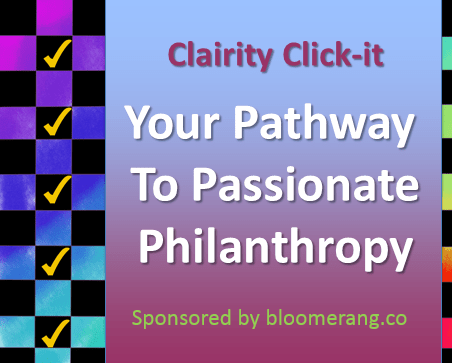 That’s right.
That’s right.
Loyalty.
Not wealth. Not money.
Not even attention. Because merely grabbing the attention of someone with either capacity or inclination to give is no guarantee philanthropy will follow.
Today I’d like to illuminate:
- Truths about what drives philanthropy,
- Challenges nonprofits have developing and implementing strategies that take these truths into account, and
- Suggestions for moving forward with a new paradigm to generate increased philanthropy.
We’ll look at two of these “truths/challenges/suggestions” today, and two more next week.
TRUTH #1: The Real Driver of Donations is Visceral Connection
You can think about loyalty as a product of who the donor is and what outcomes your organization makes possible – with the donor’s generosity.
You’re looking for donors whose connection to you is so strong they’d do almost anything for you – just as they would for their family.
They’d mourn you if you were gone.
Why would they shed a tear?
Because, if you do fundraising and marketing the right way, donors will think of you as essential to their sense of self.
Could there be a formula to express this?
Donor Identification X Commitment = Pledge to be Generous
The beginning – and duration – of a beautiful, lasting relationship is the true formula for fundraising success.
-
IDENTIFICATION: Donors identify with your cause (“I’m an ACLU supporter;” “The work of the ASPCA is part of my heart;” “Without the symphony, life would be bleak.”).
-
COMMITMENT: You become their family and community.
-
PLEDGE: They promise to become your lifelong supporter and defender.
CHALLENGE #1: Most Nonprofits Don’t Meaningfully Prioritize Connection
Do you? Or do you prioritize dollars? Are all your metrics about numbers? Numbers of donors… moves… visits… asks… money, money, money?
Don’t get me wrong. Of course, you need money. But it turns out fundraising (as we’ve come to call the process of philanthropy generation), must focus on quality as much (if not more than) quantity to be successful.
And by “successful,” I mean in service of transformative impact. Not simply focused on one-time monetary transactions.
To meaningfully repair the world means you need to reach out. You need to relate.
You can’t relate to a PERSON if all you’re thinking about is how much MONEY you can squeeze out of them.
Which suggests it’s time to reframe how you do fundraising.
SUGGESTION #1: Adopt “Generosity is the Manifestation of Radical Connection” as a Mantra
What if you were to proceed with this as a new “Golden Rule” for the survival of philanthropy?
In a recent session for the Nonprofit Marketing Summit, precisely this was suggested by thought leader Nathan Chappel. Nathan, who leads the AI team at Donor Search, spoke to how AI will change all of our futures — including how we do fundraising effectively.
AI paves the way for radical connection in a manner Nathan terms “strategic, precision philanthropy.”
This would mean every strategy and tactic you use would be designed precisely to reach potential supporters. And in a manner most directly aligned with their individual identities, interests and preferences. It goes well beyond the traditional Golden Rule with which we’re all familiar. That one is great, particularly as interpreted to do no harm, but also a bit egocentric. Based on what we individually believe is “good,” we’re asked to do as we’d “have others do unto us.” But what if what makes you feel well-treated is not the same as what makes your donor feel good?
-
If I want to be left alone, I think YOU do too.
-
If I don’t want to receive phone calls from charities, I think YOU don’t either.
-
If I hate to fill out surveys, I think YOU hate them too.
-
… and so on.
All these beliefs become excuses for not reaching to build deeper relationships with each and every one of our supporters. We worry we’ll turn donors “off,” forgetting our priority is to turn donors “on.” And this can’t be accomplished passively
TRUTH #2: You Compete for Connection, Not Dollars
In today’s attention sucking jungle, making radical connections is essential for generosity to flourish.
Given the steady downward trend in philanthropy for the past twenty years, effective philanthropy facilitation is an imperative. And facilitation means to make philanthropy easy. The better you know your donors, and understand how they identify themselves and relate to your mission, the better you’re able to deeply connect to them.
You can no longer operate as if you’re in a hunger games type competition to secure a limited number of dollars and donors from a fixed fundraising pie. The pie isn’t fixed in size! We’ve seen that in declining giving year over year – what’s been termed the Generosity Crisis. So, what’s been going on?
What’s going on is the game changed. Nonprofits today compete against everyone – businesses, candidates, influencers, social media and more – and not for a share of charitable dollars, but first simply for attention.
Attention alone is not enough.
The real struggle is for connection. And everyone has a new set of technological tools, if they’re willing to responsibly adopt them, to more efficiently grab attention and build the type of relationships that lead to loyalty.
“A vibrant healthy philanthropic sector requires us to reframe how we think about fundraising. It’s not about refilling the leaky bucket. It’s about building and strengthening embracing relationships with philanthropic partners.”
— Nathan Chappell, Senior Vice President. Donor Search Ai
CHALLENGE #2: Attention is Ephemeral; Connection is for Life
Which is why I prefer to frame the essential work of solving the world’s pressing problems as “philanthropy, not fundraising.” Philos (love) + anthropy (humanity). The emphasis must be on the love and human connection.
Love is a huge part of connection.
And the best philanthropy facilitators enable that loving connection.
Think about how you feel about pizza (or some other food, sport or hobby you can’t live without). Chances are the narrative goes something like this:
- I love pizza.
- I’d do anything to get some good pizza.
- I’m a pizza lover.
Wouldn’t you love someone to facilitate you getting that pizza you yearn for? Of course you would! It would make you feel really good. So good, in fact, you might be inclined towards future generosity.
“When people feel connected with others, one human being to another, they can experience psychological wellbeing. They don’t need to be the only person who has got power in a relationship to experience psychological wellbeing. That sense of having genuinely warm, trusting, and satisfying relationship is a very important component of people’s psychological wellbeing. Helping people experience that is both good for them and good for the people that they choose to love.”
— Jen Shang, Philanthropic Psychologist
SUGGESTION #2: Embrace Technology to Facilitate “Radical Connection” and Grow Philanthropy
Radical connection leads to generosity because the heart and the wallet are closely connected.
This is something for-profit businesses have discovered as well. Some moons ago they tended to look for “connection” in their stock market valuation. The “purpose” of business was to return value to shareholders. How you treated your employees and the world was secondary (if a consideration at all). Something changed in the mid-1990’s with the idea it was no longer enough to simply return value to shareholders. Value had to be given through building constituent connection. This was the genesis of “cause marketing,” followed by socially responsible businesses models integrating social values into company operations. Value for businesses, shareholders and consumers alike is not just what you do today, but where you’re headed in the future.
The same holds true for your constituents, most especially donors. They care not just about you knowing who they are, but who they yearn to be. You must reach deeply into their souls in order to facilitate passionate philanthropy. And, make no mistake, passion is key. If you’re nonprofit, you’re competing for lifetime value through a process of giving people meaning.
AI is a path forward towards radical, passionate connection.
“Harnessing data, cloud, AI and machine learning, enables personalization at scale, creating powerful connections and the ability to drive results.”
— Allyson Fryhoff, Managing Director, Nonprofit Business, Amazon Web Services
In Part 2 we’ll consider two more “truths/challenges/suggestions,” and I’ll offer some concluding thoughts. As I wrote last week in 4 Keys to Raise Money in Today’s Attention-Sucking Nonprofit Jungle, our job is to help people use the tools at their disposal — and yours — to share their values and passions.
Want more on this topic? Read The Generosity Crisis: The Case for Radical Connection to Solve Humanity’s Greatest Challenges, by Nathan Chappell and Michael Ashley.
Images: Three San Francisco Hearts: The Way to My Heart. Soft Light First Flight. North Beach Millefiori. Artist-created to benefit San Francisco General Hospital Foundation.
#Loyalty #Nonprofit #Donor #Currency #Part









